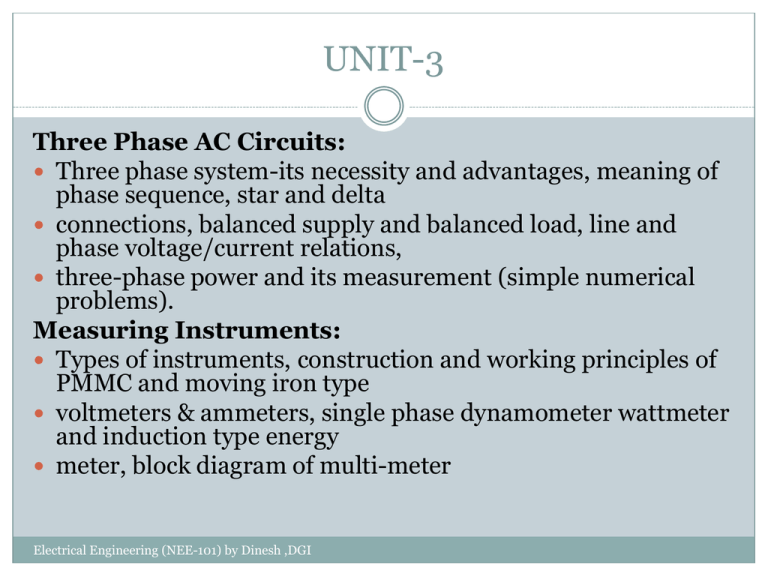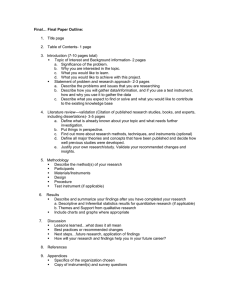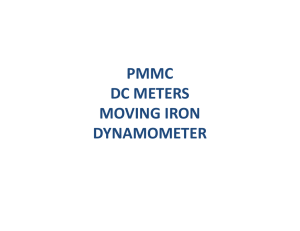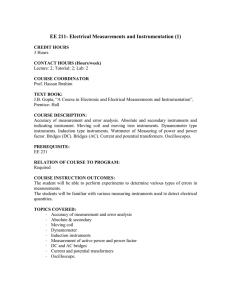Three Phase AC Circuits
advertisement

UNIT-3 Three Phase AC Circuits: Three phase system-its necessity and advantages, meaning of phase sequence, star and delta connections, balanced supply and balanced load, line and phase voltage/current relations, three-phase power and its measurement (simple numerical problems). Measuring Instruments: Types of instruments, construction and working principles of PMMC and moving iron type voltmeters & ammeters, single phase dynamometer wattmeter and induction type energy meter, block diagram of multi-meter Electrical Engineering (NEE-101) by Dinesh ,DGI Wattmeter A wattmeter is essentially an inherent combination of an ammeter and a voltmeter and, therefore , consists of two coils known as current coil and pressure coil. Wattmeter connection: Electrical Engineering (NEE-101) by Dinesh ,DGI 2-wattmeter method of measuring 3-phase 3-wire power : (a) star connected, P=W1+W2 (b) delta connected P=W1+W2 Electrical Engineering (NEE-101) by Dinesh ,DGI Determination of P.F. from Wattmeter Reading If load is balanced, then p.f. of the load can be determined from the wattmeter readings Vector diagram for balanced star connected inductive load ----- cos cos tan 1 3 W1 W2 W1 W2 The watt-ratio Curve ---------- p.f. can be determined from reading of two wattmeters Electrical Engineering (NEE-101) by Dinesh ,DGI Measuring Instruments: • Types of instruments, • construction and working principles of PMMC • Moving iron type voltmeters & ammeters, single phase dynamometer wattmeter and • Induction type energy meter, block diagram of multi-meter viewers, in this lecture we shall discuss about the following main points. Importance of measurements Analog and Digital type instruments principal, Construction, working of PMMI type instruments, Their Advantages, Disadvantages, Source of errors and much more about PMMI type instruments 6 PMMI type instruments has many importance in panel making In laborites , In industries ,in various fields for measuring the Various quantizes as shown in the slides . These instruments are more accurate ,east to use in every field of measuring the quantity. 7 8 9 An instrument for direct measurement of the strength of electric current, voltage, or the quantity of electricity in AC/DC circuits. The movable part of a permanent-magnet instrument is displaced by the interaction between the magnetic field of the permanent magnet and the conductor carrying the current. The most widespread type of permanent-magnet instrument has a movable frame 10 located in the field of a permanent magnet. When a current flows through the windings of the frame, forces are generated that produce torque. Current is supplied to the frame through springs, or tension members, which generate a counteracting mechanical torque. The action of both tensional moments causes deflection of the frame through an angle proportional to the strength of the current in the frame. 11 Extension of the measurement range for current and voltage is achieved by connecting shunts and series resistors to the frame; they may be external or builtin. Permanentmagnet instruments exist in which the permanent magnet is located in the interior of a moving coil, as well as with moving magnets mounted on an axle inside a moving coil. Permanent-magnet quotient meters are12also used. . Permanent-magnet instruments with moving magnets are simpler, smaller, and lighter, but they are less precise and sensitive than instruments with moving frames. Readings are shown by pointers or luminous indicators: a ray of light from a source is directed at a mirror mounted on the moving part of the instrument and is reflected from the mirror, generating a bright spot with a dark line in the center on the scale of the instrument. 13 . The distinguishing features of permanentmagnet moving iron type instruments are Uniform scales, Good damping, High precision And high Sensitivity, and low current consumption. Such instruments are sensitive to overloads and mechanical shock and impact but are relatively insensitive to the effect of external magnetic fields and ambient 14 temperatures. Basically an electrical indicating instrument is divided into two types. They are i) Analog instruments ii) Digital Instruments. Analog instruments are nothing but its output is the deflection of pointer, which is proportional to its input 15 Digital Instruments are its output is in decimal form. Analog ammeters and voltmeters are classed together as there are no fundamental differences in their operating principles. The action of all ammeters and voltmeters, with the exception of electrostatic type of instruments, depends upon a deflecting torque produced by an electric current. 16 In an ammeter this torque is produced by a current to be measured or by a definite fraction of it. In a voltmeter a current produces this torque, which is proportional to the voltage to be measured. Thus all analog voltmeters and ammeters are essentially current measuring devices. 17 . The essential requirements of a measuring instrument are (i) That its introduction into the circuit, where measurements are to be made, does not alter the circuit conditions; (ii) The power consumed by them for their operation is small. 18 (iii) Their connection should be simple (Iv) The measuring device should be easy to handle (v)Device should be portable in nature Because such instruments are used in Labs and industries etc 19 Ammeters are connected in series in the circuit whose current is to be measured. The power loss in an ammeter is I 2R a where I is the current to be measured and R is the resistance of ammeter. Therefore, ammeters should have a low electrical resistance so that they cause a small voltage drop and consequently absorb small power. 20 Voltmeters are connected in parallel with the circuit whose voltage is to be measured. There is also a power loss in voltmeters The voltmeters should have a high internal electrical resistance, in order that the current drawn by them is small and consequently the power consumed is small. 21 permanent magnet moving iron instruments are widely used in laboratories and switch boards at commercial frequencies because these are cheaper in cost , robust in construction and can be manufactured with required accuracy. there are two general types of such instrument i.e (i) the attraction type (ii) the repulsion type . 22 the repulsion type instrument operate on the principle of repulsion of two adjacent iron piece magnetized by the same magnetic field. repulsion type instrument are more sensitive as in these instrument large operating torque is developed by having two iron element positioned close together inside the field coil 23 Where the magnetizing effect is maximum. in both type of these instrument the current under measurement is passed through a coil of wire. this current carrying coil sets up the necessary field. depending on the magnitude of the current to be measured the coil may be of a few turns of very heavy conductor or of many turns of fine wire. 24 . the instrument to be used as an ammeter is provided with a coil of thick wire in order to have low resistance and carry large current and to be used as a voltmeter is provided with a coil of large number of turns of fine wire in order to have high resistance and draws as small current as possible. 25 permanent magnet moving iron instruments let us discuss first Repulsion type moving iron instruments Construction. The main components in Repulsion type moving iron instruments are 1 moving iron vane 2 fixed iron vane 3fixed cylindrical coil 4shaft 6hair spring 7 pointer 8 scale 26 Current in the coil induces both vanes to become magnetized and repulsion between the similarly magnetized vanes produces a proportional rotation. The deflecting torque is proportional to the square of the current in the coil, making the instrument reading is a true ‘RMS’ quantity Rotation is opposed by a hairspring that produces the restoring torque. Only the fixed coil carries load current, and it is constructed so as to withstand high transient current. 27 28 29 One iron vane is held fixed to the coil frame and other is free to rotate, carrying with it the pointer shaft. Two irons lie in the magnetic field produced by the coil that consists of only few turns if the instrument is an Ammeter or of many turns if the instrument is a Voltmeter. 30 Current in the coil induces both vanes to become magnetized and repulsion between the similarly magnetized vanes produces a proportional rotation. The deflecting torque is proportional to the square of the current in the coil, making the instrument reading is a true ‘RMS’ quantity Rotation is opposed by a hairspring that produces the restoring torque. Only the fixed coil carries load current, and it is constructed so as to withstand high transient current. 31 In permanent moving iron type instruments Weather they are attraction type or repulsion type, the deflection is directly proportional to the square of electrical current flowing ,when connected in the circuit , that is why the scale of these instruments are non linier or non uniform, so these instruments works on both type of supply AC as well DC. 32 In the repulsion type, there are two vanes inside the coil one fixed and other movable as discussed earlier These are similarly magnetized when the current flows through the coil and there is a force of repulsion between the two vanes resulting in the movement of the moving vane. Two different designs are in common use 33 (I) Radial Vane Type • In this type, the vanes are radial strips of iron. • The strips are placed within the coil as shown • The fixed vane is attached to the coil and the movable one to the spindle of the instrument •.(a) Radial vane • (b) Co-axial vane type 34 35 (ii) Co-axial Vane Type In this type of instrument, the fixed and moving vanes are sections of co axial cylinders as shown previously The controlling torque is provided by springs. Gravity control can also he used in vertically mounted instruments. The damping torque is produced by air friction as in attraction type instruments. . 36 • The operating magnetic field in moving iron instruments is very weak and therefore . eddy current damping is not used in them as introduction of a permanent magnet required for eddy current damping would destroy the operating magnetic field. • It is clear that whatever may be the direction of the current in the coil of the instrument, 37 •That there is always a force of attraction in the attraction type and repulsion in the repulsion type of instruments. Thus moving iron instruments are unpolarised instruments i.e., they are independent of the direction in which the current passes that is why these instruments can be used on Ac as well as on dc both types of supply, no rear of reading to go in reverse direction. 38 Attraction type. This instrument consists of a few soft iron discs (B) that are fixed to the spindle, pivoted in jeweled bearings. The spindle also carries a pointer , a balance weight a controlling weight ,and a damping piston which moves in a curved fixed cylinder. The special shape of the moving-iron discs is for obtaining a scale of suitable form. F 39 40 Moving-iron vanes instruments may be used for DC current and voltage measurements and they are subject to minor frequency errors only. The instruments may be effectively shielded from the influence of external magnetic fields by enclosing the working parts, except the pointer, in a laminated iron cylinder with laminated iron end covers. 41 Advantages: • The instruments are suitable for use in a.c and d.c circuits. • The instruments are robust, owing to the simple construction of the moving parts. • The stationary parts of the instruments are also simple. • Instrument is of low cost as compared to moving coil instrument. • Torque/weight ratio is high, thus less frictional error. 42 Errors: i. Errors due to temperature variation. ii. Errors due to friction is quite small as torque-weight ratio is high in moving-iron instruments. iii. Stray fields cause relatively low values of magnetizing force produced by the coil. Efficient magnetic screening is essential to reduce this effect. 43 iv. Error due to variation of frequency causes change of reactance of the coil and also changes the eddy currents induced in neighboring metal. v. Deflecting torque is not exactly proportional to the square of the current due to non-linear characteristics of iron material. 44 with both D.C. and A.C i) Hysteresis Error ii) Temperature error iii) Stray magnetic field 45 Errors with only A.C Frequency errors This error is introduced only if there is a change in supply frequency ,due to change in frequency ,readings of such type of instruments may affects or alters. 46 Advantages & Disadvantages Universal use Less Friction Errors Cheapness Robustness 47 Accuracy Scale Errors Waveform errors Non linier scales. 48 Is digital ammeter is a moving iron Instrument or moving coil instrument? Both moving iron and moving coil instruments are analogue instruments, relying on mechanical movement to display a measurement. A moving iron instrument works on the principle of attraction or repulsion between an electromagnet and an iron armature to drive its pointer. 49 . A moving coil /iron instrument works on the principle of the interaction of two magnetic fields to drive its pointer. A digital instrument, on the other hand, is completely solid-state, using electronic circuits to digitally process the information supplied by the circuit under test, and then displays the result using a digital output. 50 What is difference between Ammeter and voltmeter Main difference is of internal resistance of their operating coils, in case of ammeter ,the internal resistance is low as length of coil is less, in case of voltmeter the internal resistance is high ,another difference is of their connection , Ammeter is connected in series of supply 51 Question----- the scale of permanent magnet moving iron type instruments are non uniform or non linier why? Answer--- ---- the scale of permanent magnet moving iron type instruments are non uniform or non linier because in such type of instruments the deflection or torque is proportional to the square of current ( not current) that is why the scale is crowded near about zero so that interval is not uniform 52 Non linier scale voltmeter 53





